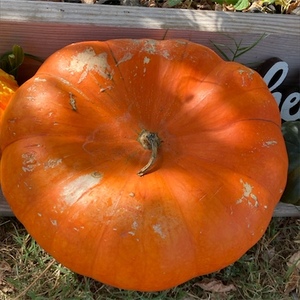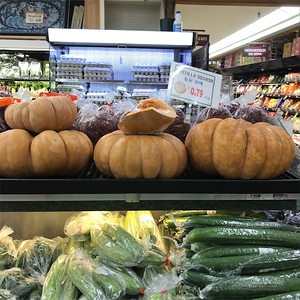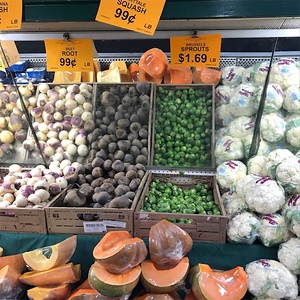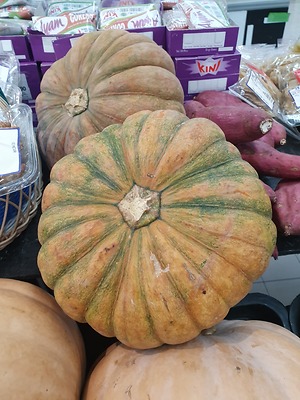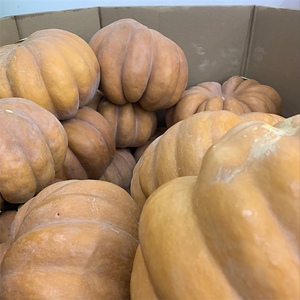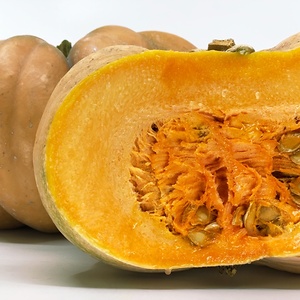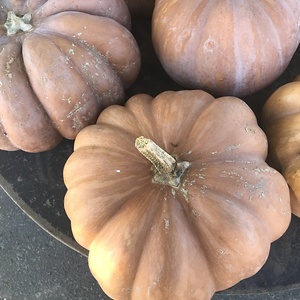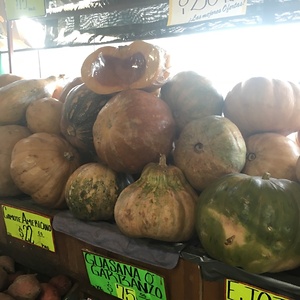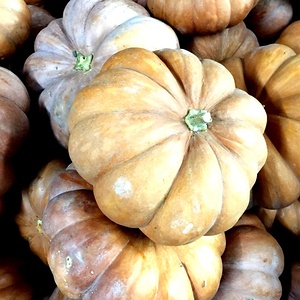


Pumpkins Fairytale
Estimated Inventory, 24" Bin : 0
This item was last sold on : 11/29/24
Description/Taste
Fairytale pumpkins are a medium to large variety, averaging 30 to 46 centimeters in width and weighing around 7 to 9 kilograms each. They have a slightly flattened, rounded oval shape, featuring a deeply lobed rind with prominent ribbing and a sturdy, light brown stem. The rind transitions from dark green to a light orange-tan when mature. Fairytale pumpkins have thick, firm, bright orange flesh with a fine texture similar to butternut squash. This flesh encases layers of mealy and stringy light-orange pulp surrounding a core of flat, cream-colored seeds. When cooked, the flesh becomes smooth, creamy, and tender, with a mild, sweet flavor and a hint of spiciness.
Seasons/Availability
Fairytale pumpkins are available in the fall through winter.
Current Facts
Fairytale pumpkins are botanically classified as Cucurbita moschata and belong to the Cucurbitaceae family, which includes watermelons, cucumbers, and squash. This French heirloom variety, known as Musque de Provence, is named after the region where it originated. It is also referred to as Moscata di Provenza and Castilla squash. Commonly known as cheese pumpkins due to their flat shape resembling cheese wheels, Fairytale pumpkins grow on vigorous vines that can exceed three meters in length and reach a height of 0.4 to 0.5 meters. As a winter squash, they are recognized for their hard, inedible rind and soft flesh that can be eaten raw. They are prized for their long storage life, sweet flavor, and ornamental value in fall decor.
Nutritional Value
Fairytale pumpkins are an excellent source of vitamin C, which is crucial for boosting the immune system, promoting healthy skin, and aiding in the absorption of iron from plant-based foods. Additionally, they are rich in dietary fiber, essential for digestive health, helping regulate bowel movements and maintaining a healthy gut microbiome. This fiber content can also assist in weight management by promoting a feeling of fullness. Fairytale pumpkins are abundant in carotenoids, including beta-carotene, a powerful antioxidant that the body converts into vitamin A. Beta-carotene is vital for maintaining good vision, supporting skin health, and enhancing immune function.
Applications
Fairytale pumpkins are ideal for both raw and cooked applications, such as sautéing, baking, boiling, and roasting. The pumpkin should be sliced from the center and used in salads, enjoyed as a snack similar to cantaloupe, or used as a garnish on main dishes. When cooked, the pumpkin can be roasted and blended into soups, stews, curries, casseroles, or cream-based sauces, and incorporated into pasta dishes. Fairytale pumpkins are also utilized in a variety of desserts and baked goods, including pies, tartlets, muffins, cakes, and cookies. They pair well with pecans, rum, eggs, onions, garlic, meats such as ground beef, poultry, and sausage, as well as fennel seeds, red bell peppers, zucchini, brown rice, quinoa, and farro. They can be stored whole in a cool, dry location for up to nine months and will keep for up to two weeks when sliced and refrigerated. Fairytale pumpkin slices can also be frozen for up to six months.
Ethnic/Cultural Info
In France, Fairytale pumpkins are known as Musque de Provence squash, a beloved variety that has gained popularity since its introduction in the 19th century. This squash is particularly valued for its unique flavor, versatility, and impressive size. Farms in the southern regions of France, where the climate is ideal for growing this heirloom variety, carefully harvest and prepare the pumpkins for market. Given their substantial size, Musque de Provence squash is typically sold in more manageable wedges, making it easier for consumers to handle and cook with. Each wedge is large enough to yield ample flesh for an entire recipe, making it a practical choice for both home cooks and chefs.
Geography/History
Fairytale pumpkins are native to France, where they have been cultivated for centuries. They thrive in warm climates with high sun exposure and well-drained soils. This cultivated variety does not grow naturally in the wild and is commonly found in home gardens and on commercial farms, particularly during the fall. Fairytale pumpkins are a hybrid developed during the 19th century in the Provence region of southern France, which borders Italy and includes the coastal French Riviera. They were introduced to the United States in 1899 and were first sold by a seed store in Chicago. Today, this French heirloom is most commonly found at farmers' markets throughout France, as well as in seasonal markets and grocery stores across the United States, Europe, and South Africa. Seeds for home gardeners to grow Fairytale pumpkins are also widely available.
Recipe Ideas
Recipes that include Pumpkins Fairytale. One



